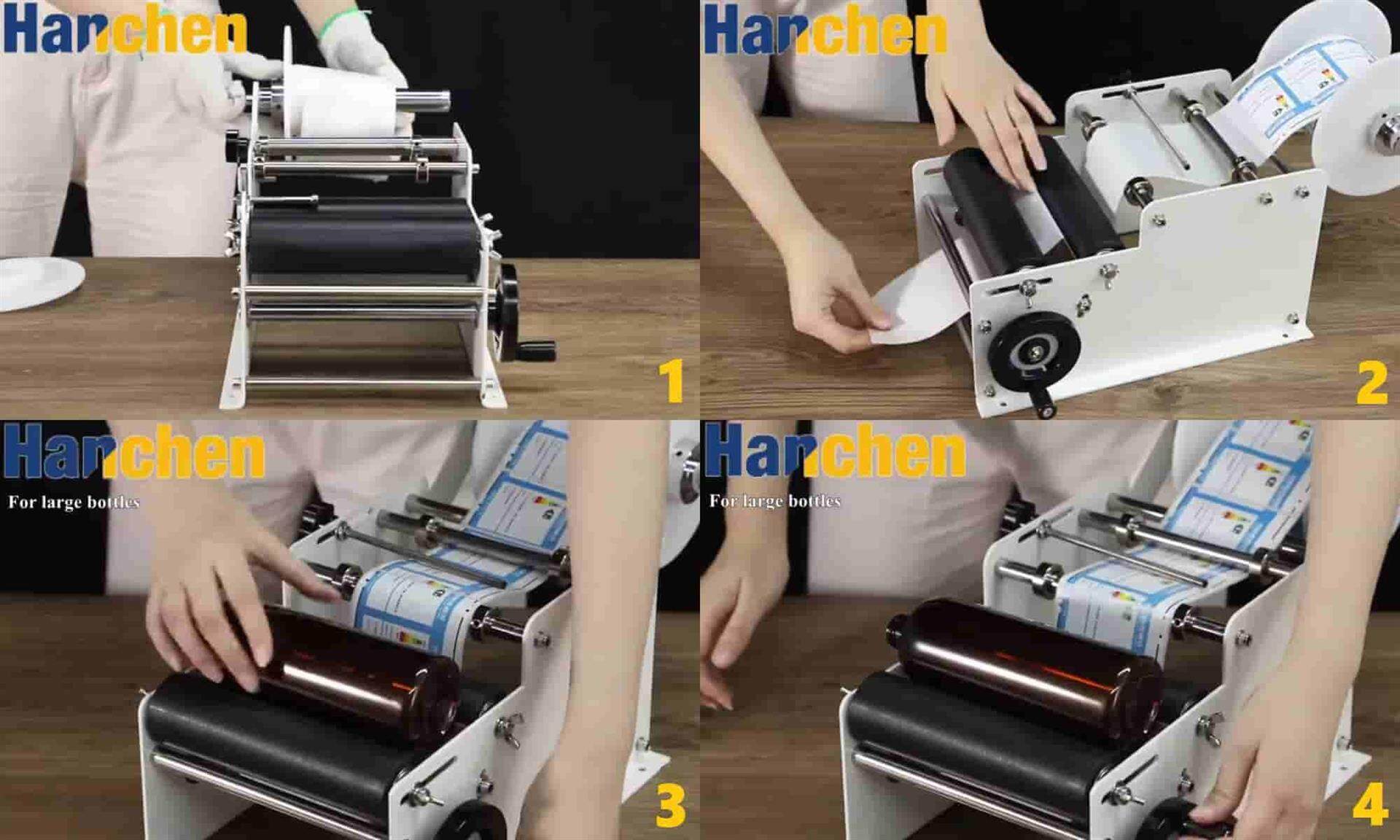How Does a Labeling Machine Work
Even if you're a veteran of the packaging world, chances are you've been overwhelmed by sudden changes in packaging printing. Or when the information on the packaging needs to be updated frequently, will you shell out for replacing the packaging without hesitation every time?

Don't fret. There is a cost-effective alternative to help you out - labeling. Using labels allows for easily changing your product information, such as nutrition facts, instructions for use, promotional messages, or tracking. It can save you quite a lot of money compared to changing the entire packaging.
You will not want to affix labels one by one by hand, will you? Now, it's time for labeling machines to come on stage. These devices can greatly improve labeling efficiency and precision without compromising consistency in the quality of your product. In this article, we will introduce you to what a labeling machine is, how it works and how to operate it safely.
Types of Labeling Machines

There are various types of labeling machines on the market to accommodate a wide range of products. Based on different factors, labeling machines can be classified into:
|
Factor |
Type |
|
Degree of Automation |
Manual Labeler |
|
Semi-automatic Labeling Machine |
|
|
Automatic Labeling Machine |
|
|
Labeling Application Method |
Side Labeling Machine |
|
Top & Bottom Labeling Machine |
|
|
Wrap-Around Labeling Machine |
|
|
Corner Wrap Label Applicator |
|
|
Label Type |
Pressure-Sensitive Labeling Machine |
|
Shrink Sleeve Labeling Machine |
|
|
Cut & Stack Label Applicator |
|
|
In-Mold Labeling Machine |
|
|
Container Style |
Round Bottle Labeling Machine |
|
Flat-Surface Label Applicator |
|
|
Oval Bottle Labeling Machine |
Labeling Machine Working Principle
In the simplest of terms, a labeling machine is used to dispense and apply labels to products. However, each type of machine is slightly different from others, especially those classified based on the level of automation. These labeling machines come in different designs and configurations. This makes them function differently.
Here, we will focus on the working principle of these three major types of labeling machines. To help you get familiar with how labeling machines work, let's break down the steps of their labeling processes.
How Does a Manual Labeling Machine Work?
As with all manual devices, these label applicators are almost hand-operated. They don't require electric energy to operate. Therefore, operator skills are indispensable when using manual labelers. The skills include not only running but also maintaining and troubleshooting the equipment. All right! Let's get back to the point. What are the steps of operating a manual labeler?

(Image Source: Hanchen)
STEP 1 Set up the labeler
Most manual labelers you bought may arrive disassembled. So, the first step is to set up the machine. A manual labeling machine is often a handy device that allows for tool-less assembly. Follow the instructions provided with the labeler. It should be noted that label stock is installed during the machine assembly process.
STEP 2 Thread the labeler
Follow the label threading path provided in the instructions. Make sure the label stock is properly aligned. Pull the tail of the label stock and thread it through several rollers of the labeler. Make sure the label stock reaches the dispensing area.
STEP 3 Place the product to be labeled
Manual labeling machines are typically designed to label round containers, such as bottles and jars. Place a bottle horizontally between two rubber rollers, where labeling takes place. The rubber rollers can be adjusted to accommodate round bottles of various diameters.
STEP 4 Apply a label to the product
Once the product is in place, turn a handle or handwheel mounted on the side of the labeler to affix a label to your product. The product can be moved from left to right, allowing labeling in any desired position. Manual labeling machines can handle square and wrap-around labels depending on your needs.
How Does a Semi-automatic Labeling Machine Work?
These labeling machines feature a certain level of automation. They are easier to operate and more time-saving than manual devices but still require human involvement. Here, we take a semi-automatic labeling machine with a printer as an example. The major steps of the labeling process in such a machine are:
STEP 1 Load the label stock
Semi-automatic labeling machines are typically tabletop equipment. So, make sure your semi-automatic label applicator is placed on an even and stable surface. Load a label stock onto the machine manually in the roll direction you want. Ensure the labels are properly in position.
STEP 2 Thread the label roll
Once the unwind direction is determined, pull the tail of the label roll and thread it through the code printing area, several rubber rollers, and the take-up roller. The take-up roller is used to collect the backing material after the labels are applied to the products. Make sure the tail of the label stock wraps around the take-up roller.
STEP 3 Place the product
As shown in the above video, the semi-automatic labeling machine is handling flat packaging. This machine is engineered to apply labels to a product's top or bottom surface. Place a product with its labeling side up on the product holder. The product holder is adjustable, allowing for labeling of various carton sizes.
STEP 4 Initiate the labeling process
Once the product and label stock are ready, press the main power switch to start the machine. Suppose your labeling machine includes a printing feature. In that case, there will be a separate control panel that allows you to turn on the printer and set the temperature. When the printer is on, wait at least five minutes to let the printer heat up. Once the heating time's up, press the foot pedal switch to start labeling.
STEP 5 Apply labels to products
Semi-automatic labeling machines often employ a vacuum pump for label application. They feature a vacuum pad that picks up labels and holds them with the suction generated. Once the product is in place, the vacuum pad moves down. It releases the vacuum to affix the label to the packaging. The labeling action is entirely controlled by the foot pedal switch.
How Does an Automatic Labeling Machine Work?
If you intend to handle a large-scale production, labeling speed and volume are critical. That's where an automatic labeling machine comes into play. An automated labeling device is designed to streamline the process while ensuring productivity and quality. Let's take a look at how automatic labeling machines typically work.
STEP 1 Prepare and thread the label stock
No matter the level of automation your equipment has, this step is inevitable. Place a label stock on the label roll holder. This component comes with a spindle that is used to place and hold the label stock as fed into the machine. Pull the tail of the label roll and thread it through rollers, the code printer, the photoelectric sensor, and the take-up reel.
STEP 2 Load products to be labeled
Suppose you're using a round bottle labeling machine. Load bottles onto an infeed turntable, which is connected to a conveyor. The loading action can be either performed by hand or an upstream conveyor. This depends on your machine configuration.
STEP 3 Feed products
The bottles are transferred to the labeling area by the conveyor. There's a spacer wheel sitting on the side of the conveyor. This component stops the passing bottles for seconds and releases them. This ensures bottles are even spaced as they pass through the labeling station on the conveyor.
STEP 4 Apply labels
When the even-spaced bottles reach the labeling area, a belt applicator dispenses labels to each bottle as they pass. The synchronous movement of the belt applicator and the conveyor enables the bottle to rotate. This allows the label to be applied to the bottle.
STEP 5 Discharge the labeled bottles
Once applied with labels, the bottles are transferred to an accumulation table. If the automatic labeling machine is integrated into a production line, the bottles will move to the next processing area.
Final Word
So, there we go, the end of our exploration journey on how the major types of labeling machines work. We hope you found this information useful when you look for a new labeling machine for your packaging business.
Leave your comment
Comments
Fascinating insights into the working principle of labeling machines! 🏭✨ From precision application to seamless integration, understanding the heart of labeling technology is a game-changer for efficient packaging.
From: Sophia | Created on: 1/19/2024 2:27 AM
Also Offers




Our Team
As an expert in the pharmaceutical and pharmaceutical packaging industry, iPharMachine has provided solutions for hundreds of pharmaceutical and health product manufacturers for 17 years. By visiting customers, we get good reviews from our customers.
- info@ipharmachine.com
- English Español Deutsche







